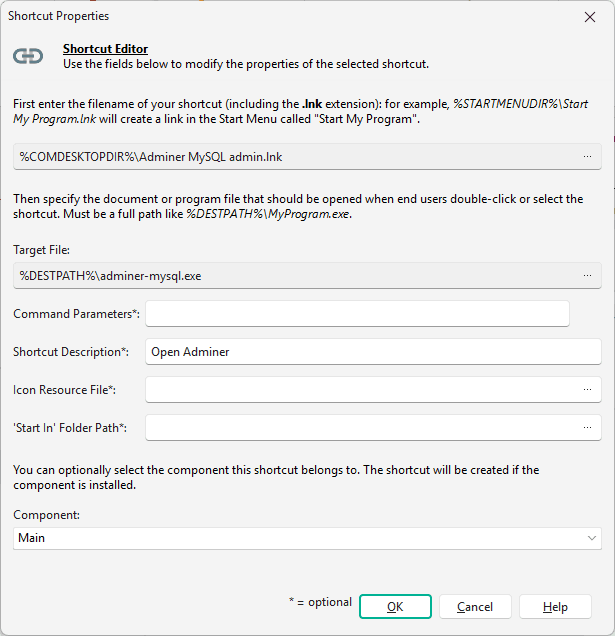Create shortcuts¶
This page allows you to create shortcuts to your extracted files and place them on the user's desktop, in the Start menu or even in a folder of the Start menu (a "Program Group"). This feature is available with custom actions, but it is much easier to manage shortcuts using this editor.
Using the Shortcut Manager¶
-
To add a shortcut, click the Add button. The list of files inside your package is displayed: select the file your shortcut should point to (in other words the file that should be opened when users double-click the shortcut) and the Shortcut editor dialog will be opened.
-
To remove a shortcut, select it and click the Remove button or press DEL.
-
To edit a shortcut, select it and click the Edit button, or double-click it.
Using the mouse context menu (right click a shortcut item), you can also copy/cut/paste shortcuts. This feature is useful if you wish to keep properties of a shortcut and only change its name and destination file (for example, if you create several shortcuts that should be placed in the same folder: it will prevent you from entering the destination folder each time). You can also change the size of icons used to display shortcuts: small or large.
Tip
You can easily and quickly create shortcuts directly from the File Manager using the mouse's context menu command "Create a shortcut".
Creating a Start Menu Folder for your shortcuts¶
If you would like for instance to place shortcuts to an application installed by your package, or to some document files, you need to know where to place these shortcuts. If you have a lot of shortcuts to create, it is recommended that you put them in a sub-folder of the Windows Start Menu that we call "Start Menu Folder" or "Program Group".
Default Start Menu Folder Name¶
Paquet Builder automatically configures the package to determine the full path to the Start Menu folder, all you need to do is to enter a name for your own Start Menu Folder. This can be something like "My Application 1.0" for example. You may also use resource strings in this field.
The final path will be stored by the package in the variable %SHORTCUTPATH%; you can use it to create your shortcuts (see below).
Prompt end users for the Start Menu Folder¶
If you enable this option, the package will display a dialog (or a wizard step) asking end users to enter the name of the Start Menu Folder in which they want your shortcuts to be placed. They can select an existing folder or enter a new one. Note that the default start menu folder specified above is shown by default.
The result is automatically stored in the %SHORTCUTPATH% variable as mentioned above.
Create shortcuts for All Users¶
When this option is enabled, all shortcuts will be created for all users instead of the current user. %SHORTCUTPATH% will be based on %COMPROGMENUDIR% instead of %PROGMENUDIR%.
Shortcut Properties¶

Shortcut Filename¶
In this field, please enter the full path to the shortcut file that should be created. You may use variables for special shell folders like the Desktop or Programs Menu: press the variable  button to display the list of variables.
button to display the list of variables.
%SHORTCUTPATH% is the variable managed by the package to store the path to the Start Menu Folder optionally selected by the end user. It is recommended that you use it.
Do not forget the extension (.lnk).
The filename of the shortcut is used by Windows on Windows desktop for example (the text that appears near the icon of your shortcut).
Example: %DESKTOPDIR%\My Application.lnk will cause the package to create a shortcut on the user's desktop.
Target Filename¶
This is the file that will be executed by Windows when you double-click the shortcut. Enter the full path to the file. If this is a document file like text or help file, the associated application will be executed to view it. You can select a file using the Browse button.
Example: %DESTPATH%\Binaries\MyApp.exe
Info
If you want to create Internet shortcuts (pointing to a URL), you can use this custom action instead, or as "Target Filename" enter the URL to the wished page.
Command Parameters¶
If you would like to pass switches or any command to the application opening the target file (or to the target itself if it is a program), please enter them in this field. Optional.
Shortcut Description¶
Enter an optional description for your shortcut (not the filename!). For example, Documentation or My Icon Library. This description appears in a tip window when you move the mouse cursor onto the shortcut icon.
Icon Resource File¶
Enter the full path to the file containing the icon that should represent the shortcut. If the field is left blank, the shortcut will take the icon associated with its target file. It is important to store the icon resource file in a folder which is accessible by All Users, otherwise the icon won't display correctly. You can use icons (.ico) or PE files (.exe, .dll...). If your resource file contains several icons, it is possible to indicate which icon should be used by adding | immediately followed by the icon index to the file path. Optional.
Example: %DESTPATH%\iconres.dll|4 will cause the shortcut to have the icon number 4 from the iconres.dll file.
Start-In Folder Path¶
Tells Windows which folder should be set as the current one when the shortcut is activated. Optional.
Component¶
Specifies the component's name the shortcut belongs to. Generally your shortcut should belong to the component that contains its target file. Components are listed in the list: use the "drop down" button to see available components. If the component is not installed, then the shortcut will not be created.
Set the component to None if you want the shortcut to be always created.
Info
If you add an uninstaller to your package, shortcuts are automatically removed by it.